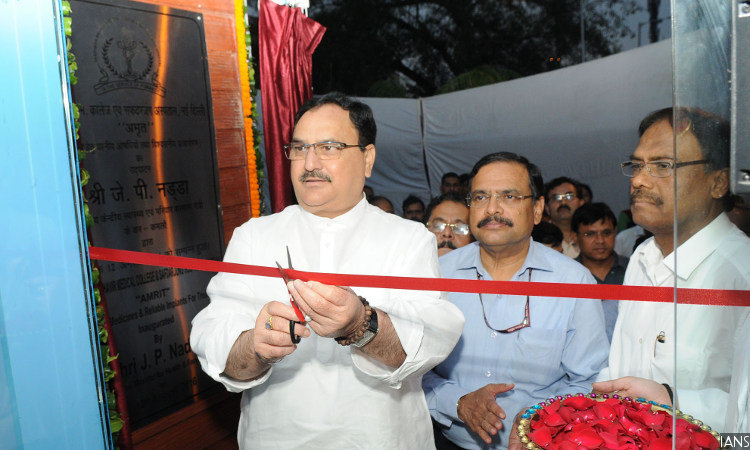Repackaged: 15-Year-Old National Health Policy Resurrected In 2017

India's new national health policy (NHP), released by health and family welfare minister J P Nadda on March 16, 2017, is largely a repackaged version of a similar document released in 2002 with similar funding commitments and targets, according to FactChecker’s analysis of both documents.
Ambitious infant- and maternal-mortality and disease elimination targets rolled out under the NHP 2017 are the same targets fixed 15 years ago; these targets were to be achieved by 2010. The new health policy has now fixed 2019 or later to achieve these targets.

Source: National Health Policy, 2017, National Family Health Survey, 2015-16, Ministry of Statistics & Programme Implementation
The NHP 2017 will address “the current and emerging challenges necessitated by the changing socio-economic, technological and epidemiological landscape”.
#NationalHealthPolicy2017 is comprehensive & futuristic, placing the interests of the citizens first & foremost. https://t.co/2emooDj6fd
— Narendra Modi (@narendramodi) March 16, 2017
The new health policy declares it will increase health spending to 2.5% of gross domestic product (GDP), which is Rs 2.83 lakh crore ($42 billion)--nearly as much as the budget estimate for defence spending for 2017-18, from 1.16% of GDP in 2015.
The 2002 policy said the government--then headed by Atal Bihari Vajpayee of the Bharatiya Janata Party (BJP)--would increase health spending to 2% of GDP, which never happened either under the National Democratic Alliance (NDA-1) or during 10 years of the United Progressive Alliance (UPA) administration.
Here is what our fact check of main targets fixed by the national health policy of 2017 found:
1. The NHP 2017 sets a target of reducing infant mortality rate (IMR, or infant deaths per 1,000 live births) to 28 by 2019; the target set in the 2002 health policy was to reduce it to 30 by 2010. The IMR in 2015-16 was 41.
2. The NHP 2017 sets the target for maternal mortality ratio--deaths of women per 100,000 live births--at 100 to be achieved by 2020; the target set in 2002 was to reduce it to 100 by 2010. The MMR in 2015-16 is 167.
3. The NHP 2017 has set the target to eliminate leprosy by 2018, kala azar (black fever or visceral leishmaniasis) by 2017 and lymphatic filariasis (elephantiasis) in endemic pockets by 2017. The 2002 NHP had set the target of eliminating leprosy by 2005, kala azar by 2010 and lymphatic filariasis by 2015--none of which could be achieved yet.
4. The NHP 2017 has set the target of reducing the incidence of new tuberculosis cases and reach elimination status by 2025. This would mean a reduction of 95% in new cases, FactChecker reported on March 15, 2017. The 2002 document set the target of reducing mortality due to TB by 50% by 2010. The mortality rate for TB was 59.7 per 100,000 population in 2000, which reduced to 42.6 in 2010, missing the target set. In 2015, TB mortality rate was 35.9 per 100,000 population.
Source: National Health Policy, 2017; National Family Health Survey, 2015-16, Ministry of Statistics & Programme Implementation, Ministry of health & Family Welfare
This is not the first time India is failing to achieve health targets. The 12th five-year plan (2012-17) had a target to reduce IMR to 25 and MMR to 100, reduce total fertility rate--children born per woman of childbearing age (15 to 49 years)--to 2.1 and raise sex ratio in the 0-6 year age group to 950 per 1,000 by 2017, which it has failed to achieve, according to National Family Health Survey 2015-16 data. IndiaSpend had reported about India missing health targets in 2013.
Apart from setting targets, the NHP 2017 is also planning to introduce yoga “more widely in schools and workplaces as part of promotion of good health”. The policy also seeks to move away from “sick care to wellness” with the thrust on “prevention and health promotion”.
Primary health centres, which will now be called as “health and wellness centres”, will include care for non-communicable diseases, mental health, geriatric care, palliative care and rehabilitative care services.
Correction: In an earlier version of the story, the second graph erroneously showed the maternal mortality ratio to be 258 deaths per 100,000 births. The correct datum is that the MMR was 167 deaths per 100,000 births in 2015-16. Secondly, the public spending on health expenditure for 2010 had been rounded off in the first graph, from 1.35% of the gross domestic product to 1.4%. We have now made the corrections and regret the errors.
(Salve is an analyst and Yadavar is principal correspondent with IndiaSpend and FactChecker.)



